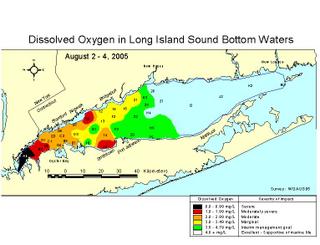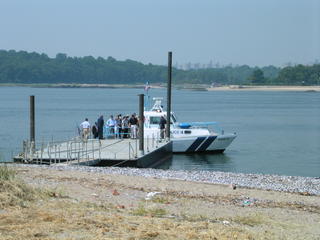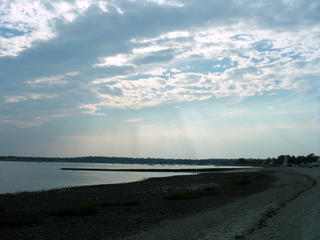The power went off Friday night at 8:30. The thunderstorm that caused it was one of the strongest I remember. We were partially prepared -- we found candles easily but Kaare, my 7-year-old son had taken the batteries out of the emergency flashlight to put in his toy trucks. This didn't thrill me although it did give me the opportunity to act fatherly and tell him that emergency flashlights were for emergencies and that if the batteries were in the trucks, we wouldn't have them for emergencies. This of course seemed ridiculous and probably patronizing to him, but he had the good grace to listen respectfully. As it grew dark, he and I and his 12-year-old sister, Elie, went outside to sit under the eaves on the front step and watch the lightning and listen to the thunder, which barreled overhead without pause. When it was completely dark we all headed upstairs and managed to get ourselves to bed by the light of votive candles.
Saturday morning was hot and sticky, of course, and since we've been softened by five years in a house with central air conditioning, we all thought we would perish if the power didn't come on soon. I called NYSEG, and its automated phone system told me the lights were expected back by 11 a.m. But at 11, we still had no power, so I called again. This time the automated voice said it would be back by 1 p.m.
My daughter was at work at the New Canaan farmers market (she unloads the truck, helps set up, and bags vegetables for Riverbank Farm, which is in Bridgewater, Connecticut, I think). Gina, Kaare and I decided to pick her up when her shift ended at noon, and then hang out in the air conditioning at the New Canaan Library. Then at 1:30 Kaare and I walked over to the movie house, where we watched March of the Penguins, which was both amazingly beautiful and idiotically anthropomorphic. The a.c. was so high in the theater that Kaare had to keep visiting the lobby and bathroom to warm up. I myself wished it were a double feature.
We were home shortly after 3. The power wasn't on. I called NYSEG again. The estimate now was 5 p.m. Gina, Kaare and Elie went to the pool at the town park. I read in the increasingly stifling house and then napped. I woke at 5. The power was out. I called again: 9 p.m.
I called Sole, a restaurant in New Canaan that we like because the waiters are Italian, they act like the enjoy serving you, they take your order without having to write it down, and they serve your food without having to ask, "Who ordered the prosciuto e melone?" because they actually remember who ordered the prosciuto e melone. We also like it because the food is good, as are the martinis. I made a reservation for four for 7:30. When Gina, Kaare and Elie got back from the pool, we packed up some clothes and drove to my mother-in-law's house, which is in the same town, less than a mile from ours, and which had power and hot water and three showers, so we could clean up quickly and make it to the restaurant on time. Sole was good, although it was warm enough inside that the waiters had to pour table salt on the floor to soak up the condensation to keep people from slipping.
It was almost 10 when we got home -- to a dark house. I was close to despondent. I had called NYSEG four or five times and each time the automated voice had said the power would be back on. In truth, I really had no idea whether NYSEG even knew we were without power, whether its automated reporting system really worked. We found our flashlights, grabbed some clothes and two fans (although not, because I was feeling rushed to get the kids into bed, my tennis stuff, even though I had an 8:30 game on Sunday morning), and headed back to my mother-in-law's. We needed the fans because her house, which is low and shaded and has stone floors and so is generally cool in summer, has no air conditioning. We were soon comfortable and asleep, and I woke up at 8, realizing that I needed to get coffee and something to eat, and to drive back home to get my tennis stuff, so I could be at the court, which is an 8-minute drive away, by 8:30. While coffee was brewing, I drove home. The power was out.
I called NYSEG again: 11 a.m. was the new prediction. I dressed, grabbed my racket, and left for the courts. We played doubles til about 10:45. When I got home this time, the lights were on, the condenser was humming and the inside of the house was cool. I quickly drove back to my mother-in-law's, helped pack up our stuff, and we all came home happy.
By this time I had decided we weren't going to head down to Stamford to sail on the
SoundWaters. Back in April I had given a talk about Long Island Sound, based on my book, to the new SoundWaters crew. Shane Walden, the captain, had asked me and I agreed to do it without pay because on the next day I was scheduled to give a talk for pay to Audubon Connecticut, and I knew the SoundWaters talk would be a good rehearsal. To thank me, Shane sent me four passes for the schooner, and a couple of weeks ago I had made reservations for the Sunday afternoon, August 14, ecological cruise, which includes trawling and other demonstrations. With the power back on in late morning, I checked the
MYSound site for the weather conditions. The apparent temperature on the Sound was already in the 90s. Having gone to Davids Island on Thursday, I had a good recent memory of how hot and uncomfortable it can be on the Sound. And with the western end of the Sound stuck with generally low dissolved oxygen concentrations, I wasn't sure the trawl would pull up much anyway. So two and a half hours at home in the air conditioning seemed like a better idea than two and a half hours on the SoundWaters.
Then at 2 p.m., the sky darkened, thunder and lightning roared through again, rain poured. And at 2:30 the power went out.
It rained and rained. The thunder slammed above us for hours. At 3:30 I flipped on the transistor radio and was surprised to hear that the Yankees were playing in the Bronx, maybe 30 miles to the south -- no rain there. At 6, when the rain had slowed a bit, Kaare and I decided to drive around town to see who had lights. We were back in 15 minutes and as we pulled up the driveway we saw that we had lights. Soon after the phone rang. It was a nice woman from NYSEG, just asking if our lights were back. Yes, I told her.
"I understand you had quite a storm down there," she said.
"Yes, it's been raining for hours," I said. "Where are you calling from?"
"Brewster," she said. Brewster is about 15 miles to the north. "We got maybe two drops."
It rained and thundered til midnight. But the power stayed on.







